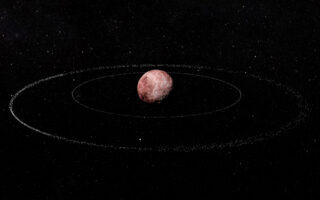Fragments of asteroid with mystery origin are found outside Berlin

Scientists have found pieces of a meteorite that fell near Berlin just after midnight on January 21. It is a rare find, from an asteroid that was identified just before it entered Earth’s atmosphere. Only a handful of such events in the recent past have allowed astronomers to trace an incoming rock’s origin in the solar system.
Early analysis of the fragments has shown something equally rare. The meteorite is an aubrite, a class with unknown origins that some scientists argue may be pieces of the planet Mercury. They are so rare that they made up just 80 of the 70,000 or so meteorites that were collected on Earth before last month’s event.
“It’s really exciting,” said Sara Russell, a meteorite expert at the Natural History Museum in London. “There are very, very few aubrites.”
The asteroid that became the meteorite (or rather fragments of meteorite) was initially spotted by Krisztián Sárneczky, a Hungarian astronomer, three hours before it hit Earth’s atmosphere. A network of cameras tracked the incoming rock, 2024 BX1, as it fell near Ribbeck, a village outside Berlin. Estimates suggest the rock was tiny, less than 3 feet in size. It still made a brilliant flash that cameras in many parts of Europe picked up.
As soon as he heard the news of the meteorite fall, Peter Jenniskens, an astronomer at the SETI Institute in California, bought a plane ticket.
“On Saturday afternoon I learned about it,” he said. “On Saturday late evening I was on a plane to Berlin.”
During a nine-hour layover in Newark, New Jersey, Jenniskens calculated where pieces of the meteorite might be found so that, when he landed early Monday, he and nearly two dozen students and volunteers could start looking for fragments immediately.
For days they trawled through fields around Ribbeck. “We couldn’t find anything,” he said.
But that Thursday, Jan. 25, a Polish team of meteor hunters announced that it had found the first piece of the meteorite. “They could show us what to look for,” Jenniskens said. The meteorites weren’t black, as expected from the passage through the atmosphere, but light, like terrestrial rocks.
With this information, in just two hours a member of Jenniskens’ team, a student at Freie Universität Berlin named Dominik Dieter, found a meteorite just sitting on top of the soil. More were quickly spotted.
“It was incredible,” Jenniskens said. “We found over 20 fragments.”
Researchers at the Natural History Museum in Berlin analyzed the minerals in the fragments using an electron microprobe. That revealed that the rocks appeared to be aubrites. It was the first time such meteorites had been collected in a tracked fall.
The source of aubrites, named after the French town of Aubres near where they were first found, remains mysterious, as their composition does not match other known sources of meteorites in the solar system. Some research has suggested they are fragments of the planet Mercury, but not all scientists support that origin story.
If aubrites came directly from Mercury, 2024 BX1 should have originated in the inner solar system. However, tracing back its path, it appears that the asteroid’s initial orbit was much wider and outside Earth’s orbit.
“Therefore this object could not have come to us directly from Mercury,” said Marc Fries, a planetary scientist at NASA’s Johnson Space Center.
It is possible, though, that aubrites were ejected from Mercury long ago into the asteroid belt between Mars and Jupiter, forming a group called E-type asteroids. The orbit of 2024 BX1 does not rule out this idea completely, although Fries remains skeptical.
Whatever their origin, 2024 BX1’s fragments will prove scientifically fascinating. “I’m sure it’s going to be a priority to find out what its composition is and how it compares to other meteorites,” Russell said.
Tracking asteroids as small as this before they hit Earth’s atmosphere is also crucial for defending the planet from asteroids. Davide Farnocchia, from NASA’s Center for Near Earth Object Studies, said smaller objects from space go undetected all the time but can pose problems to people on the ground, such as the 65-foot-wide Chelyabinsk meteor that exploded over Russia in 2013 and injured hundreds of people. Knowing the trajectories in advance could give people time to reach safety.
“If you could send a warning, nobody would get hurt,” he said.
This article originally appeared in The New York Times.






